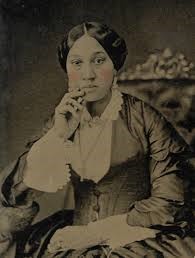Arabella Chapman Miller (1859 – 1927) [Section 104, Lot 448]
First African American Student to graduate from Albany Free Academy (Albany High School).

Arabella Chapman was born on November 15, 1859, in Jersey City, N.J. She was one of five children to Harriet Alfarata and John R. Chapman, a boatman. Her family moved to Albany in 1864. Albany had an established black community with successful businessmen, like the “Black” Schuylers, and was a key city for the Underground Railroad with key abolitionists, like Stephen and Harriet Myers. One of the state’s earliest African American political conventions, the 1840 Convention for the Colored Inhabitants of the State of New York, was hosted in Albany. Her father most likely knew the Schuylers given their similar careers. While in Albany, her father worked at the Delavan House, possibly with the assistance of Stephen Myers who was also employed there. The Delavan House was known to hire free African Americans and runaway slaves before the passage of the 13th Amendment in 1864.
As a youth, Arabella and her siblings attended the Wilberforce School, a “public elementary school for black children,” named after a British abolitionist. Located at 37 Chestnut Street, the school had been in operation since 1845. Striving for educational equality Stephen Myers fought the Albany Board of Commissioners which ended up in the NYS Supreme Court. In 1873, the Wilberforce School closed, thanks to a bill by William Henry Johnson, which “prohibited school officials from denying black children entry into any public school.” The Wilberforce school building was later converted into School 16 of the Albany Public School system. This lawsuit was the first that James C. Matthews, the first black graduate of Albany Law School, undertook. Albany Schools were desegregated and Albany Free School was established. Later known as Albany High School, Arabella became the first black student to graduate in 1877. By 1880, she was a music teacher in the area. In the future, James Matthews would become the first elected black judge in the United States.
In 1886 Arabella married Clarence Blake Miller at the A.M.E. Church, with a newspaper citing that “all the city’s best people were in attendance.” The New York Freeman described it as “an elaborate affair, one that was a testament to the status and aspirations of the Chapman-Miller family.” Originally from Albany, Clarence worked in the resort business, the couple residing in North Adams, M.A., which had another successful black enclave. Together they had three daughters, their first died as a child. The family moved back to Albany during the 1910’s, where they spent the remainder of their lives.
Arabella’s family became well connected within Albany society. Her brother, John worked as a Republican Party activist, which was founded by Albany native Thurlow Weed. Her sister, Harriet Alfarata Chapman Thompson, worked in the catalog department at the New York State Library.


Between the years of 1870 –1890, Arabella put together two photo albums of her family and friends; Elizabeth Myers, daughter of Stephen and Harriet is one of those portrayed. What makes these books rare is the insight revealed into everyday black American life. At Left, depicts one of her albums, at Right a page from that album.
These albums were passed down to her daughter Harriet, eventually ending up in the University of Michigan’s William L. Clements Library. Between 2013 - 2015, 35 undergraduate students from the University of Michigan Department of Afro-American and African Studies researched the history of the albums. Their examination reveals a glimpse into her experiences, and the lives of other Afro-Americans in the late Nineteenth century. A website was created to showcase their research. All 96 images are available for viewing by searching The Arabella Chapman Project
Arabella died on February 16, 1927, at the age of 67 at her home at 247 Second Street of Arterial Sclerosis, and Chronic Endocarditis. She is buried in her parent’s lot.